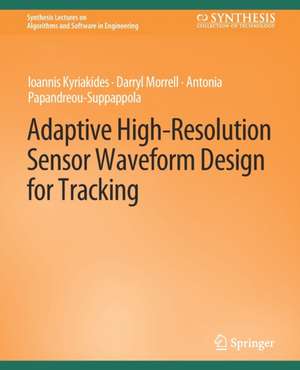Adaptive High-Resolution Sensor Waveform Design for Tracking: Synthesis Lectures on Algorithms and Software in Engineering
Autor Ioannis Kyriakides, Darryl Morrell, Antonia Papandreou-Suppappolaen Limba Engleză Paperback – 21 noi 2010
Din seria Synthesis Lectures on Algorithms and Software in Engineering
-
 Preț: 380.37 lei
Preț: 380.37 lei -
 Preț: 260.95 lei
Preț: 260.95 lei -
 Preț: 384.31 lei
Preț: 384.31 lei -
 Preț: 351.11 lei
Preț: 351.11 lei -
 Preț: 262.47 lei
Preț: 262.47 lei -
 Preț: 206.29 lei
Preț: 206.29 lei -
 Preț: 192.63 lei
Preț: 192.63 lei -
 Preț: 206.29 lei
Preț: 206.29 lei -
 Preț: 261.91 lei
Preț: 261.91 lei -
 Preț: 192.05 lei
Preț: 192.05 lei -
 Preț: 204.76 lei
Preț: 204.76 lei -
 Preț: 204.76 lei
Preț: 204.76 lei -
 Preț: 379.48 lei
Preț: 379.48 lei -
 Preț: 414.65 lei
Preț: 414.65 lei -
 Preț: 192.41 lei
Preț: 192.41 lei -
 Preț: 389.88 lei
Preț: 389.88 lei -
 Preț: 205.92 lei
Preț: 205.92 lei -
 Preț: 260.56 lei
Preț: 260.56 lei -
 Preț: 266.70 lei
Preț: 266.70 lei -
 Preț: 381.43 lei
Preț: 381.43 lei
Preț: 207.83 lei
Nou
Puncte Express: 312
Preț estimativ în valută:
39.77€ • 41.09$ • 33.10£
39.77€ • 41.09$ • 33.10£
Carte tipărită la comandă
Livrare economică 26 martie-09 aprilie
Preluare comenzi: 021 569.72.76
Specificații
ISBN-13: 9783031003875
ISBN-10: 303100387X
Ilustrații: VIII, 101 p.
Dimensiuni: 191 x 235 mm
Greutate: 0.2 kg
Editura: Springer International Publishing
Colecția Springer
Seria Synthesis Lectures on Algorithms and Software in Engineering
Locul publicării:Cham, Switzerland
ISBN-10: 303100387X
Ilustrații: VIII, 101 p.
Dimensiuni: 191 x 235 mm
Greutate: 0.2 kg
Editura: Springer International Publishing
Colecția Springer
Seria Synthesis Lectures on Algorithms and Software in Engineering
Locul publicării:Cham, Switzerland
Cuprins
Introduction.- Radar Waveform Design.- Target Tracking with a Particle Filter.- Single Target tracking with LFM and CAZAC Sequences.- Multiple Target Tracking.- Conclusions.
Notă biografică
Ioannis Kyriakides received his B.S. degree in Electrical Engineering in 2003 from Texas A&M University. He received his M.S. and Ph.D. degrees in 2005 and 2008, respectively, from Arizona State University. His research interests include Bayesian target tracking, sequential Monte Carlo methods, radar waveform design, and compressive sensing and processing. He is currently a lecturer at the Electrical and Computer Engineering Department of the University of Nicosia. Darryl Morrell received his B.S., M.S., and Ph.D. degrees in Electrical Engineering in 1984, 1986, and 1988 from Brigham Young University. He is currently an Associate Professor at Ari[1]zona State University in the Department of Engineering; as the Associate Chair, he is participating in the implementation of a multi-disciplinary undergraduate engineering program using innova[1]tive, research-based pedagogical and curricular approaches. His technical research interests include stochastic decision theory applied to sensor scheduling and information fusion and application of research based pedagogy to engineering education. Antonia Papandreou-Suppappola is a Professor in the School of Electrical, Computer and Energy Engineering at Arizona State University. Her research interests and expertise are in the areas of Adaptive Waveform Design for Agile Sensing, Time-varying Signals and Systems Processing, and Stochastic Processing for Detection, Estimation and Tracking. Her funded research work on sensing and information processing includes the development of optimal waveform selection and config[1]uration algorithms using sequential Monte Carlo and stochastic approximation techniques for the detection and tracking of targets in diverse environments; these include underwater, wideband, or dispersive environments, environments with high noise or clutter, urban terrain or requiring multiple or multi-modal sensors.
